Many people wish to know how to blanch Broccoli. But now that you’re here, you’re in luck. First, what does Blanching broccoli mean? It is a basic cooking technique that involves boiling vegetable in salted water and plunging it into ice water to stop the cooking process.
This method can help retain the broccoli’s nutrients, colour, and texture while also making it easier to digest.
In this article, we will go over step-by-step instructions on how to blanch broccoli so you can enjoy this healthy and delicious vegetable in a variety of dishes. Whether you’re cooking for yourself or a crowd, blanching broccoli is a great way to elevate your meals
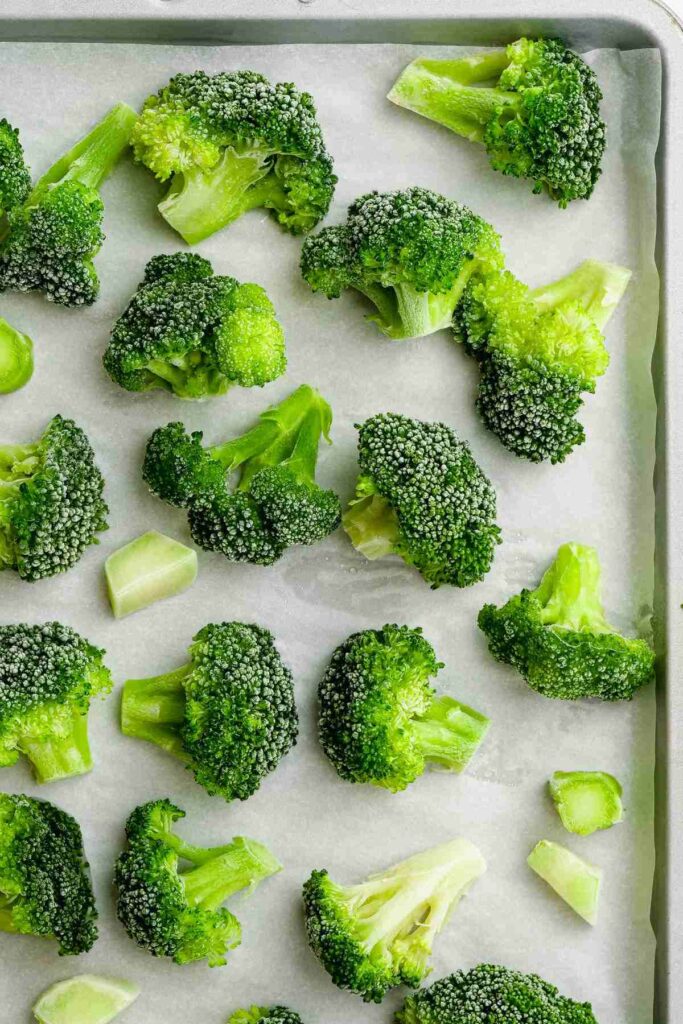
READ ALSO:
What is Blanching?
Blanching is a process where food is placed into boiling water (or steam) for a brief period and then quickly placed in ice water to prevent it from cooking all the way through.
The amount of time needed to blanch different vegetables varies. It is important not to overcook a vegetable because over-blanching leads to a loss of flavour, colour, and nutrients.
If you plan to freeze the blanched veggies, under-blanching can increase enzyme activity that compromises the quality of the veggies. Check our infographic for the appropriate blanching times of some common veggies.
Method of Blanching Broccoli
Two types of blanching methods can be used for broccoli:
- Water Blanching
In this method, the broccoli is briefly boiled in a large pot of salted water and then immediately transferred to a bowl of ice water to stop the cooking process. This method is commonly used for blanching vegetables, including broccoli.
- Steam Blanching
In this method, the broccoli is placed in a steamer basket over boiling water and cooked until it is just tender. The broccoli is then immediately transferred to a bowl of ice water to stop cooking. This method is less common than water blanching but can be a good option if you don’t want to submerge your vegetables in water.
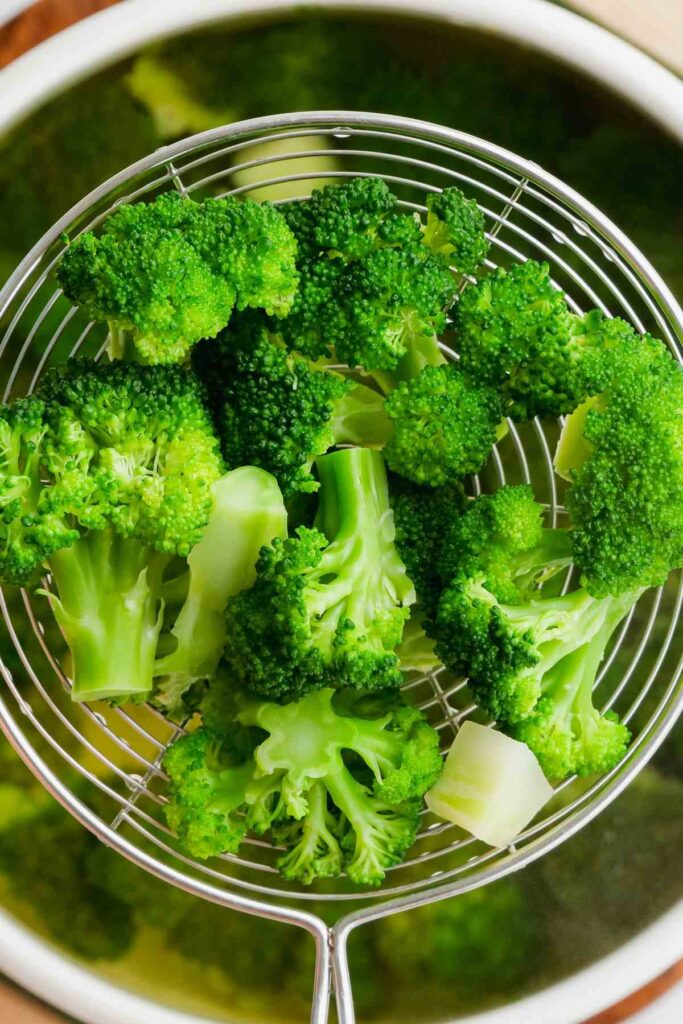
How to Water Blanch Broccoli
- Prep the broccoli
Wash and cut the broccoli to your desired size. Ensure you make all of your florets the same size to cook at the same rate.
- Boil the water
Fill a large, heavy pot ⅔ of the way full with water. Cover the pot and place it on the stove over high heat. Once the water reaches the boiling point, add 1 tablespoon of salt to the water. Adding salt to boiling water helps to increase the boiling point of the water. This, in turn, assists in cooking your food more efficiently.
- Prepare your ice water bath
While you are waiting for your pot of water to boil, fill a large bowl with cold water and a few ice cubes.
- Cook your broccoli.
Once your pot of water begins to boil, carefully place the cut broccoli into the boiling water. Start counting the blanching time once the water returns to a boil. To be sure, your broccoli should be bright green and firm (though slightly softened) when you remove it from boiling.
- Cool your broccoli down.
Either remove the broccoli with a slotted spoon or small sieve or drain the broccoli water. Immediately place the broccoli in the ice bath to stop the cooking process. Remove the cooled florets from the cold water. After 30 seconds, you can strain them in the colander.
- Serve
As with other vegetables, blanching your broccoli can be the primary cooking method or the first step before sauteing or stir-frying. Secondary cooking methods (such as sauteing) primarily add flavour to vegetables and don’t usually cook the vegetables as thoroughly as needed. Blanching is a great way to pre-cook vegetables to be added to sauté and stir-fry.
How to steam Blanch Broccoli
- Clean and prepare your broccoli
Cut the broccoli down into consistently-sized florets for uniform cooking.
- Prep for steaming
Fill a large pot with 1–2 inches (2.5–5.1 cm) of water and bring it to a boil. Place your vegetables in a steam basket that sits above the water line. Cover the pot and prepare an ice-water bath. Try to arrange the florets in a single layer to ensure the steam evenly reaches all broccoli parts.
- Time your steam cooking
When steam begins to escape, begin counting your blanching time. Steam blanching broccoli takes approximately 5 minutes. Halfway through the cooking time, remove the lid and make sure the broccoli is not clumping together and that it is all cooking evenly.
- Stop the cooking process
Once your broccoli has been blanched, remove the steam basket from the pot and immediately place the broccoli into the ice water.
- Complete the blanching
After the broccoli has cooled in the ice water, drain the broccoli in a colander and allow the florets to dry before eating or packing for freezing.
Tips for Blanching Vegetables
Keeping to recommended blanching time is crucial and varies with vegetables and their sizes. Under-blanching your broccoli stimulates the activity of enzymes and proteins that cause changes in color, texture, flavor, and nutrients, which is worse compared to not blanching at all. Over-blanching causes loss of flavor, color, vitamins, and minerals.
Follow these blanching tips for high-quality frozen vegetables:
- Don’t overload the process. Processing small quantities at a time, generally, 1 pound of prepared vegetables, will mean that water returns to a boil quickly (within 1 minute) after vegetables are added.
- Use either steam or hot water for blanching; avoid microwave blanching.
- Follow stated blanching times. Use tested recipes for best quality; start timing the blanching process as soon as the water is boiling (or steam is being produced).
- Cool immediately once the heating is complete. Once blanching time is up, stopping the heating process is important.
- To cool, plunge vegetables into a bowl of icy water. The rule of thumb is cooling time is equivalent to blanching time. If you blanch your broccoli for 1 minute in boiling water, then cool it for 1 minute in ice water. Then drain.
- Drain cooled vegetables before to packing them for the freezer. Excess moisture can cause a loss of quality when vegetables are frozen.
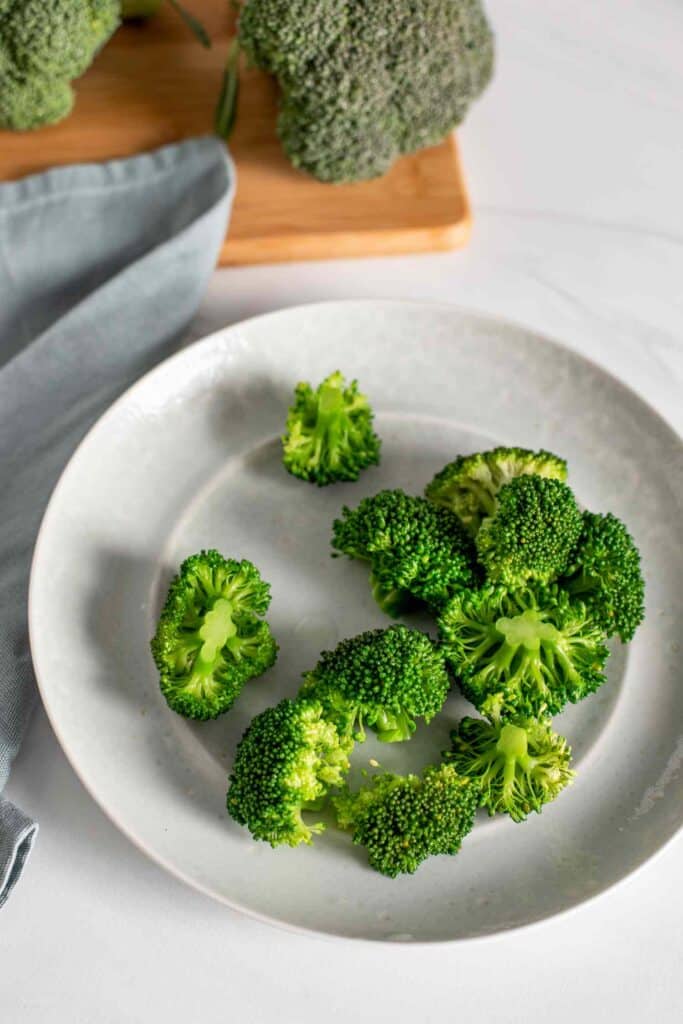
Broccoli Health Benefits
Broccoli is a vegetable that has a reputation for having a high antioxidants. It is low in calories but contains a wealth of nutrients and antioxidants that support many aspects of human health.
- Helps Fight Cancer
Cancer occurs when malignant cells develop and spread throughout the body. While modern medicine helps kill cancerous cells, don’t underestimate the cancer-fighting potential of broccoli. This vegetable may help reduce your risk of certain cancers like lung, stomach, and colon cancer.
- Helps With Bone Health
Vitamin K helps your body absorb calcium, and a deficiency increases the risk of bone fractures. Because broccoli contains a high amount of vitamin K, there is an association between eating it and reduced fracture. Broccoli also contains calcium, which is another essential nutrient for strong bones and teeth.
- Improves Immunity
Ever wonder how some people can go through cold and flu season without a sneeze? The secret might be a stronger immune system and their ability to fight off illnesses.
- Improves skin health
Vitamin C helps the body produce collagen, which is the main support system for body cells and organs, including the skin. As an antioxidant, vitamin C can also help prevent trusted Source skin damage, including wrinkling due to ageing.
- Helps With Weight Loss
Broccoli is also an excellent food for weight loss. Along with being low in calories, this fibre-rich food can help you stay full longer and may curb overeating. It can also improve digestion and help relieve constipation.
- Keeps You Hydrated
There are about 68 grams of water in a cup of raw broccoli. Consuming enough water helps keep your body’s cells and organs healthy. Staying hydrated also regulates your body’s temperature, provides lubrication for your joints, and prevents constipation by moving food through the digestive tract.
READ ALSO:
- Junk Food: Why?
- Vegetable Soup Recipes: How To Cook the Nigerian Efo Riro
- How to cook fried rice one step at a time
- How to cook Okro Soup – Nigerian Okro Soup Recipe
Why you should Blanch
Blanching is an important cooking technique that can be used for a variety of reasons, especially when it comes to preparing vegetables like broccoli. Here are some reasons why you should blanch broccoli:
- Preserves nutrients
Blanching broccoli helps to preserve its colour, texture, and, most importantly, nutrients. This is because the brief blanching process helps to stop the enzymatic activity that can cause vegetables to break down and lose their nutritional value.
- Enhances flavour
Blanching broccoli can help to enhance its flavour by reducing bitterness and softening the texture. By blanching the broccoli before adding it to a recipe, you can ensure that it has a bright, vibrant colour and a mild, slightly sweet taste.
- Improves texture
Blanching broccoli can also help to improve its texture by making it more tender and easier to digest. This is particularly important for dishes where the broccoli is not cooked for very long, such as stir-fries or salads.
- Removes impurities
Blanching broccoli can help remove any dirt or debris on the surface of the vegetable. This can help make it safer to eat and improve the dish’s overall appearance.
Broccoli Recipes in Nigeria
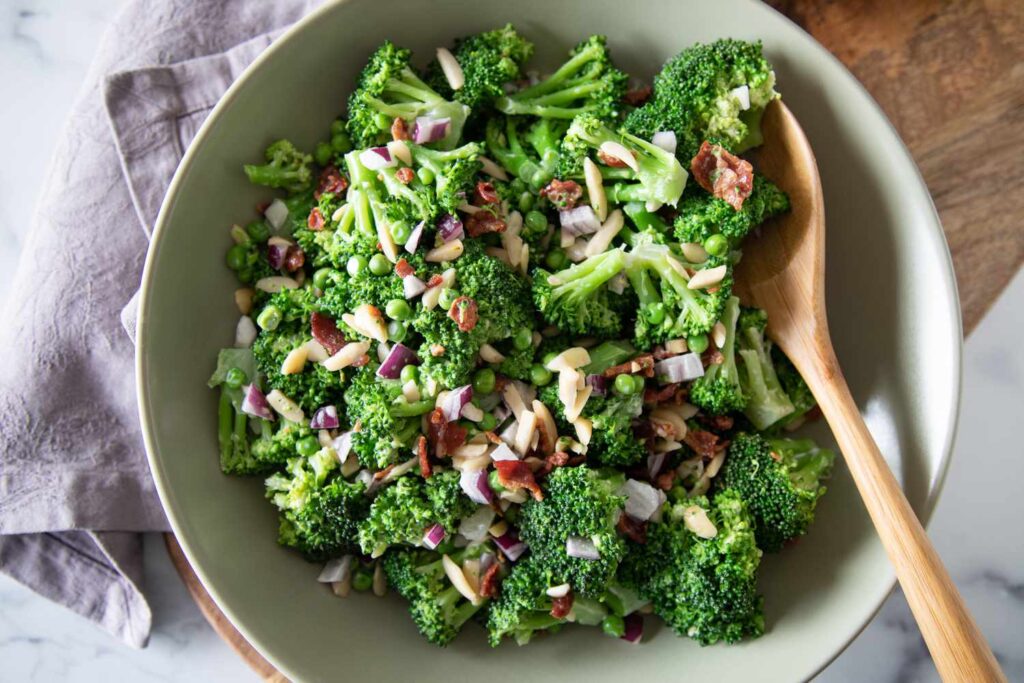
- Broccoli Salad:
Ingredients:
- 1 head of broccoli, chopped into small florets
- ½ onion, diced
- 2 tomatoes, chopped
- 2 tbsp olive oil
- 1 tbsp honey
- 1 tbsp lemon juice
- Salt and pepper to taste
Instructions:
- Blanch the broccoli florets by boiling them in salted water for 2-3 minutes, then drain and transfer to a bowl of ice water to cool.
- Whisk together the olive oil, honey, lemon juice, salt, and pepper in a separate bowl to make the vinaigrette dressing.
- Add the diced onions and chopped tomatoes to the bowl of blanched broccoli, then pour the dressing over the top and toss to combine.
- Serve the salad chilled.
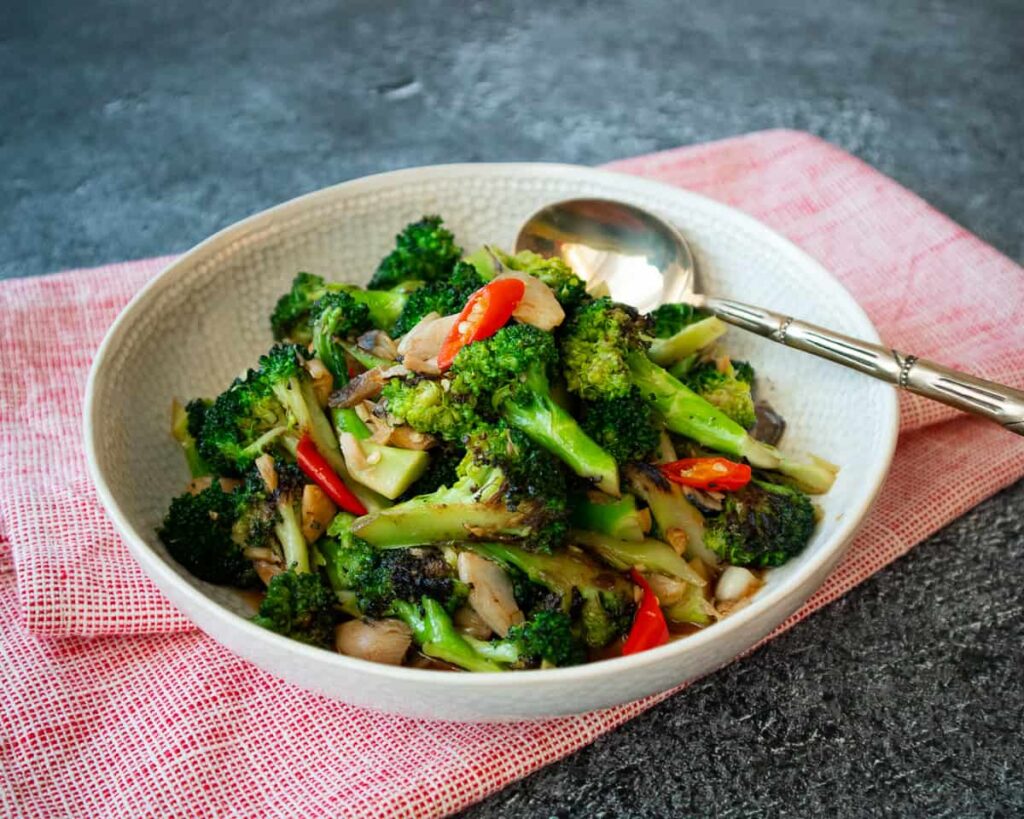
2 Broccoli Stir-Fry:
Ingredients:
- 1 head of broccoli, chopped into small florets
- ½ lb chicken breast, diced
- 1 bell pepper, sliced
- 1 onion, sliced
- 3 cloves garlic, minced
- 2 tbsp soy sauce
- 1 tbsp sesame oil
- Salt and pepper to taste
Instructions:
- Blanch the broccoli florets by boiling them in salted water for 2-3 minutes, then drain and set aside. Heat a large skillet over medium-high heat and add the diced chicken.
- Cook until browned on all sides, then add the sliced bell pepper, onion, and garlic. Cook for another 2-3 minutes.
- Add the blanched broccoli to the skillet and toss to combine with the chicken and vegetables. Whisk together the soy sauce, sesame oil, salt, and pepper in a small bowl. Pour the sauce over the stir-fry and toss to coat.
- Serve the stir-fry hot with rice or noodles.
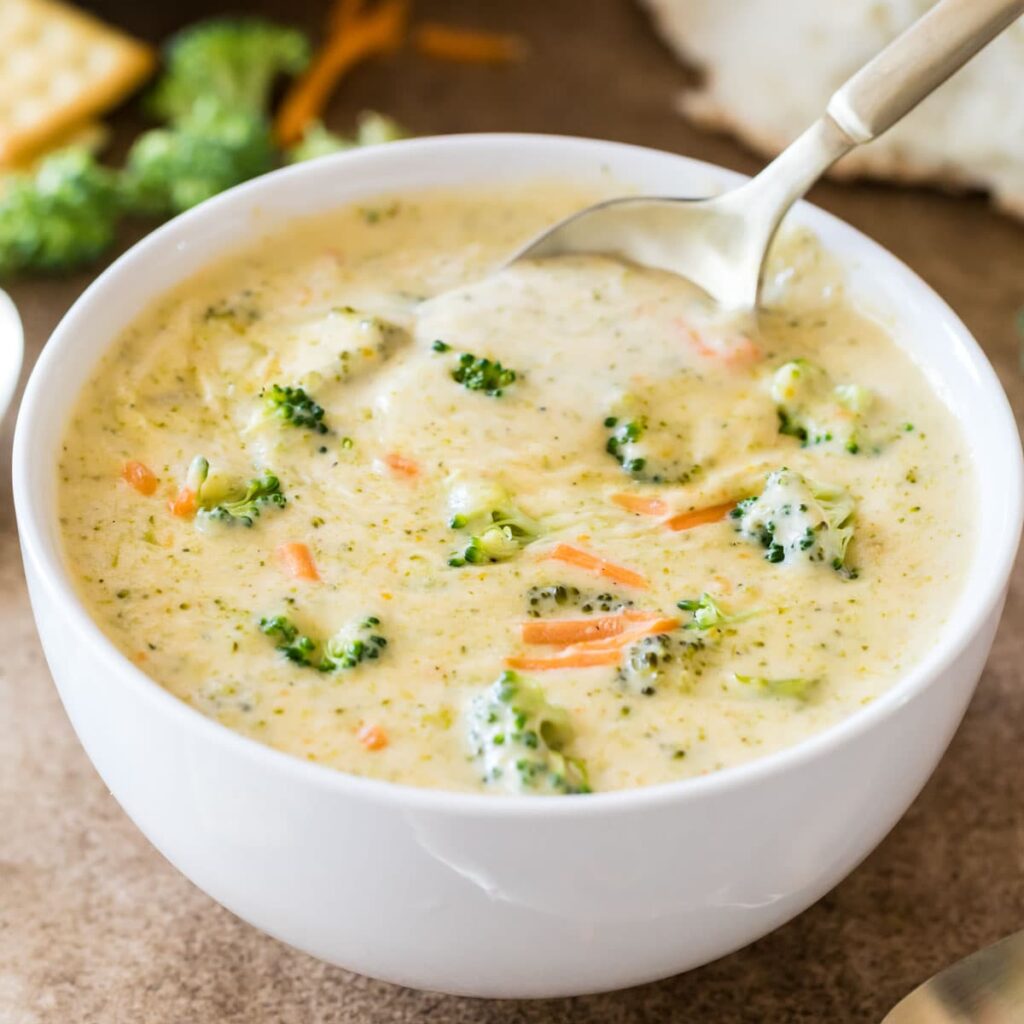
3. Broccoli Soup
Ingredients:
- 1 head of broccoli, chopped into small florets
- 4 cups chicken broth
- 1 cup heavy cream
- 1 onion, diced
- 3 cloves garlic, minced
- Salt and pepper to taste
Instructions:
- In a large pot, sauté the diced onion and minced garlic until softened.
- Add the chopped broccoli florets and chicken broth to the pot. Bring to a boil and simmer for 15-20 minutes until the broccoli is tender.
- Use an immersion blender or transfer the soup to a blender to puree until smooth.
- Stir in the heavy cream and season with salt and pepper to taste.
- Serve the soup hot with some crusty bread on the side.

4. Broccoli and Cheese Casserole:
Ingredients:
- 1 head of broccoli, chopped into small florets
- 2 tbsp butter
- 2 tbsp all-purpose flour
- 1 cup milk
- 1 cup shredded cheddar cheese
- ½ cup breadcrumbs
- Salt and pepper to taste
Instructions:
- Blanch the broccoli florets by boiling them in salted water for 2-3 minutes, then drain and set aside.
- In a saucepan, melt the butter over medium heat. Add the flour and whisk to combine.
- Gradually pour in the milk while constantly whisking to prevent lumps from forming. Cook until the sauce thickens.
- Add the shredded cheddar cheese to the sauce and stir until melted.
- In a greased casserole dish, layer the blanched broccoli and cheese sauce.
- Sprinkle the breadcrumbs over the top of the casserole.
- Bake in a preheated oven at 350°F for 20-25 minutes until the breadcrumbs are golden brown, and the casserole is bubbly.
8. Serve the broccoli and cheese casserole hot as a side dish or a main dish with a salad on the side.

Broccoli Frittata
How to Prepare Broccoli Frittata
30 minutes
Blanching
Blanch the broccoli florets by boiling them in salted water for 2-3 minutes, then drain and set aside.
Oil Bleach
Heat the olive oil in a large skillet over medium heat. Add the diced onion and cook until softened.
Adding the Blanched Broccoli
Add the blanched broccoli florets to the skillet and toss to combine with the onion.
Seasoning
Season with salt and pepper to taste.
Egg Broccoli Mixture
Pour the beaten eggs over the broccoli and onion mixture into the skillet. Sprinkle the shredded cheddar cheese over the top of the eggs.
Cooking
Cover the skillet and cook over low heat for 10-12 minutes until the eggs are set, and the cheese is melted.
Pre-Serving
Use a spatula to slide the frittata out of the skillet and onto a serving plate.
Serving
Slice the frittata into wedges and serve hot for breakfast, lunch, or dinner.
These are just a few examples of the many ways you can incorporate broccoli into Nigerian cuisine. Whether you prefer it in a salad, soup, stir-fry, casserole, or frittata, broccoli is a versatile and healthy ingredient that can be enjoyed in many different ways.
Blanching broccoli is a simple yet important cooking technique that can help to preserve its nutrients, enhance its flavour and texture, and remove any impurities.
You can enjoy the full benefits of following the proper blanching techniques and using the blanched broccoli in various Nigerian recipes like stir-fries, soups, salads, casseroles, and frittatas.
This nutritious and versatile vegetable. So next time you’re cooking with broccoli, consider blanching it first to achieve the best possible flavour, texture, and nutritional value.
